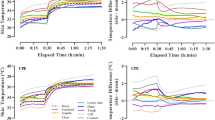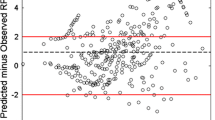Abstract
The purpose of this study was to determine a way of estimating the strain of the breast during exercise and to enable an engineering analysis of breast motion. Three participants exercised on a treadmill wearing a sports bra, an everyday bra or no bra and the motion of the body and the nipple were recorded using a 200 Hz passive marker motion capture system. Each participant also performed a breast drop test to determine the neutral position of the nipple; this allowed strains to be estimated from the point when nipple acceleration was approximately that due to gravity. Wearing any bra reduced the strain at the nipple by lifting the breast mass up towards the neutral position where the skin of the breast was neither in tension nor in compression. Non-linearities in strain occurred during the downward phase of running at strain values exceeding the static value at up to 70% strain; these were consistent with the previous studies on skin. It was postulated that comfort scores might be related to elements of the acceleration–strain curve and that nipple motion causing strain beyond static strain might be an important parameter in understanding breast pain.






Similar content being viewed by others
References
Cooper A (1829) Illustrations of the diseases of the breast, part 1. Longman, Rees, Orme, Brown and Green, London
Velpeau A (1854) Maladies du sein. Masson, Paris
Davies EL, Gately CA, Miers M, Mansel RE (1998) The long term course of mastalgia. J R Soc Med 91:462–464
The BRIDGE Study Group (1999) The presentation and management of breast symptoms in general practice in South Wales. Br J Gen Pract 49(447):811–812
Smith RL, Pruthi S, Fitzpatrick LA (2004) Evaluation and management of breast pain. Mayo Clinic Proc 79:353–372
Mason B, Page KA, Fallon K (1999) An analysis of movement and discomfort of the female breast during exercise and the effects of breast support in three case studies. Aust J Sci Med Sport 2:134–144
Wilson MC, Sellwood RA (1976) Therapeutic value of a supporting brassiere in mastodynia. Br Med J 2:90
BeLieu RM (1994) Mastodynia. Obstet Gynecol Clin North Am 21(3):461–477
Dixon JM (1999) Managing breast pain. Practitioner 243:484–486, 488–489, 491
Hadi MSA (2000) Sports brassiere: is it a solution for mastalgia? Breast J 6:407–409
Page K, Steele J (1999) Breast motion and sports brassiere design, implications for future research. Sports Med 27:205–211
Fung YC (1993) Mechanical properties of living tissues, 2nd edn. Springer, New York, p 568
Veronda DR, Westman RA (1970) Mechanical characterization of skin deformations. J Biomech 3:111–124
Reihsner R, Baloghx B, Menzel EJ (1995) Two-dimensional elastic properties of human skin in terms of an incremental model at the in vivo configuration. Med Eng Phys 17(4):304–313
Silver FH, Freeman JW, DeVore D (2001) Viscoelastic properties of human skin and processed dermis. Skin Res Technol 7:18–23
Scurr J, White J, Hedger W (2009) Breast displacement in three dimensions during the walking and running gait cycles. J Appl Biomech 25:322–329
Haake SJ, Scurr J (2010) A dynamic model of the breast during exercise. Sports Eng 12(4):189–197
McGhee DE, Steele J (2006) How do respiratory state and measurement method affect bra size calculations? Br J Sports Med 40:970–975
Lorentzen D, Lawson L (1987) Selected sports bras: a biomechanical analysis of breast motion while jogging. Phys Sports Med 15:128–139
Scurr J, White J, Hedger W (2010) Supported and unsupported breast displacement in three-dimensions during treadmill activity. J Sports Sci 29(1):55–61
Scurr J, White J, Hedger W (2010) The effect of breast support on the kinematics of the breast during the running gait cycle. J Sports Sci 28(10):1103–1109
Starr C, Branson D, Shehab R, Farr C, Ownbey S, Swinney J (2005) Biomechanical analysis of a protocol type sports bra. J Textile Apparel Technol Manufact 4:1–14
White J, Scurr J, Smith N (2009) The effect of breast support on kinetics during over-ground running performance. Ergonomics 52:492–498
Chen F, Brown GM, Song M (2000) Overview of three-dimensional shape measurement using optical methods. Opt Eng 39(1):10–22
Author information
Authors and Affiliations
Corresponding author
Rights and permissions
About this article
Cite this article
Haake, S., Scurr, J. A method to estimate strain in the breast during exercise . Sports Eng 14, 49 (2011). https://doi.org/10.1007/s12283-011-0071-6
Published:
DOI: https://doi.org/10.1007/s12283-011-0071-6




